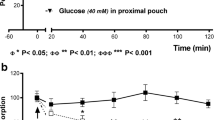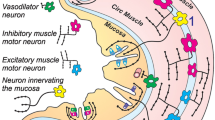Summary
The effect of intravenous infusion of dopamine (10 and 25 μg·kg−1·min−1 consecutively) on visceral blood flow distribution was examined in anesthetized cats using the microsphere technique and electromagnetic flowmetry. Arterial blood pressure did not change in response to dopamine infusion, but blood flow through the superior mesenteric artery, and blood flow in the mucosa-submucosa of the gastric antrum and various gut segments increased significantly. During infusion of the high dose the increase was most marked in the mucosa-submucosa of the antrum (+355%) and distal colon (+371%). By contrast, blood flow decreased in the muscularis-serosa of the gut segments investigated, in the spleen, pancreas, and the hepatic arterial bed. The increase in blood flow through the superior mesenteric artery was blocked by the dopamine antagonist bulbocapnine (10 mg/kg i.v.). The results suggest that the receptors mediating the dopamine-induced vasodilation in the gastrointestinal tract are located in the resistance vessels of the mucosa-submucosa.
Similar content being viewed by others
References
Angehrn W, Schmid E, Althaus F, Niedermann K, Rothlin M (1980) Effect of dopamine on hepatosplanchnic blood flow. J Cardiovasc Pharmacol 2:257–265
Anwar N, Mason DFJ (1981) Actions of dopamine and apomorphine on the vasoconstrictor responses of perfused mesenteric arteries of the mouse, rat and rabbit. J Pharm Pharmacol 33:150–154
Archibald LH, Moody FG, Simons M (1975) Measurement of gastric blood flow with radioactive microspheres. J Appl Physiol 38:1051–1056
Bell C (1982) Dopamine as a postganglionic autonomic neurotransmitter. Neuroscience 7:1–8
Eble JN (1964) A proposed mechanism for the depressor effect of dopamine in the anesthetized dog. J Pharmacol Exp Ther 145:64–70
Forssmann WG, Grube D (1973) Studien über die endokrinen Zellen des Magendarmtraktes. I. Histotopographische, fluoreszenzmikroskopische und ultrastrukturelle untersuchungen an Katze und Ratte. Z Zellforsch 140:535–550
Fujita T, Kobayashi S (1978) Paraneural cells in the GEP endocrine system. In: Bloom SR (ed) Gut hormones. Churchill Livingstone, Edinburgh, pp 414–422
Goldberg LI (1972) Cardiovascular and renal actions of dopamine: potential clinical applications. Pharmacol Rev 24:1–29
Goldberg LI, Kohli JD (1981) Specific dopamine receptors in vascular smooth muscle. In: Vanhoutte PM, Leusen I (eds) Vasodilatation. Raven Press, New York, pp 131–140
Greenway CV, Murthy VS (1972) Effects of vasopressin and isoprenaline infusions on the distribution of blood flow in the intestine; criteria for the validity of microsphere studies. Br J Pharmacol 46:177–188
Greenway CV, Lawson AE, Mellander S (1967) The effects of stimulation of the hepatic nerves, infusions of noradrenaline and occlusion of the carotid arteries on liver blood flow in the anaesthetized cat. J Physiol (London) 192:21–41
Grimaud D, Livrelli N, Dolisi CL, Philip F, Maestracci P (1981) Effets de la dopamine sur les index hépatique et cardiaque chez l'homme. Nouv Presse Med 10:1031–1035
Håkanson R, Owman C, Sjöberg NO, Sporrong B (1970) Amine mechanisms in enterochromaffin and enterochromaffin-like cells of gastric mucosa in various mammals. Histochemie 21:189–220
Håkanson R, Larsson LI, Nishizaki H, Owman C, Sundler F (1973) A new type of formaldehyde-induced fluorescence in a population of endocrine cells in cat antro-pyloric mucosa. Histochemie 34:1–9
Hirsch LJ, Ayabe T, Glick G (1975) Response of portal vein, hepatic artery and superior mesenteric artery flows to direct dopamine infusion. Fed Proc 34:459
Kullmann R, Wassermann K, Rissing R, Huss R (1979) Species differences of dopaminergic vasodilation in the intestine. In: Imbs JL, Schwarz J (eds) Peripheral dopaminergic receptors. Pergamon Press, Oxford, pp 199–210
Langer SZ, Dubocovich ML (1979) Physiological and pharmacological role of the regulation of noradrenaline release by presynaptic dopamine receptors in the peripheral nervous system. In: Imbs JL, Schwarz J (eds) Peripheral dopaminergic receptors. Pergamon Press, Oxford, pp 233–245
Lautt WW (1981) Role and control of the hepatic artery. In: Lautt WW (ed) Hepatic circulation in health and disease. Raven Press, New York, pp 203–226
Maxwell LC, Shepherd AP, Riedel GL, Morris MD (1981) Effect of microsphere size on apparent intramural distribution of intestinal blood flow. Am J Physiol 241:H408-H414
McCornack RL (1965) Extended tables of the Wilcoxon matched pair signed rank statistic. J Am Statist Assoc 60:864–871
McNay JL, McDonald RH, Goldberg LI (1965) Direct renal vasodilatation produced by dopamine in the dog. Circ Res 16:510–517
Pendleton RG, Finlay E, Sherman S (1975) Effect of bulbocapnine as a peripheral dopamine receptor antagonist in the anesthetized cat. Naunyn-Schmiedeberg's Arch Pharmacol 289:171–178
Peschl L (1978) Klinische und experimentelle Untersuchungen über die Wirkung von Dopamin auf die Hämodynamik und Funktion von Niere und Leber. Wien Klin Wschr 90, Suppl 86:3–33
Robie NW, McNay JL (1977) Comparative splanchnic blood flow effects of various vasodilator compounds. Circ Shock 4:69–78
Ross G, Brown AW (1967) Cardiovascular effects of dopamine in the anaesthetized cat. Am J Physiol 212:823–828
Rudolph AM, Heymann MH (1967) The circulation of the fetus in utero: methods for studying distribution of blood flow, cardiac output and organ blood flow. Circ Res 21:163–184
Schümann HJ (1959) Über den Hydroxytyramingehalt der Organe. Naunyn-Schmiedeberg's Arch Exp Path Pharmakol 236:474–482
Shepperson NB, Duval N, Massingham R, Langer SZ (1982) Differential blocking effects of several dopamine receptor antagonists for peripheral pre- and postsynaptic dopamine receptors in the anesthetized dog. J Pharmacol Exp Ther 221:753–761
Author information
Authors and Affiliations
Rights and permissions
About this article
Cite this article
Kullmann, R., Breull, W.R., Wassermann, K. et al. Blood flow redistribution by dopamine in the feline gastrointestinal tract. Naunyn-Schmiedeberg's Arch. Pharmacol. 323, 145–148 (1983). https://doi.org/10.1007/BF00634262
Received:
Accepted:
Issue Date:
DOI: https://doi.org/10.1007/BF00634262




